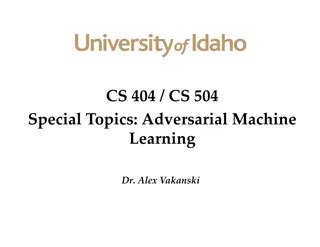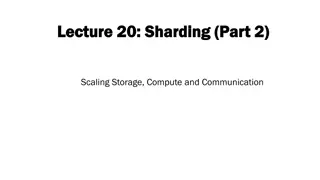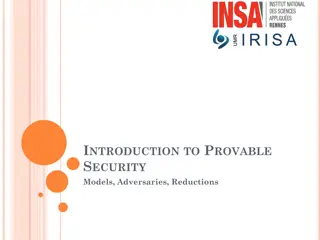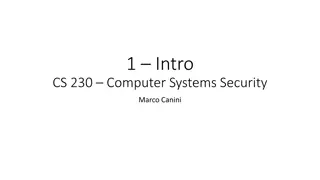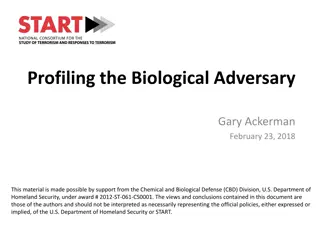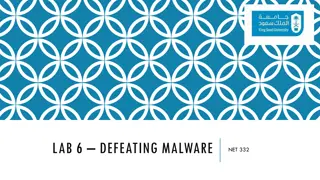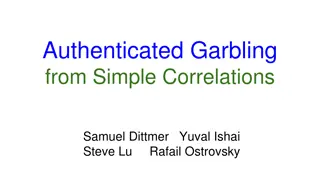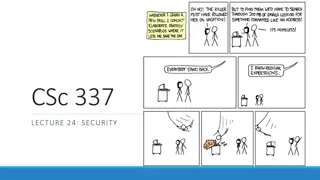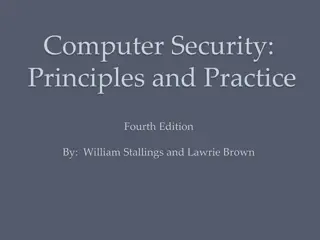Security Against Malicious Adversaries: Issues and Solutions
This content discusses security measures against malicious (active) adversaries in cryptographic protocols. Topics include handling input dependencies, randomness, fairness, and deviation from protocol instructions. It explores solutions such as the GMW Compiler Theorem, input independence, coin-tossing protocols, and zero-knowledge proofs.
Uploaded on Mar 02, 2025 | 1 Views
Download Presentation

Please find below an Image/Link to download the presentation.
The content on the website is provided AS IS for your information and personal use only. It may not be sold, licensed, or shared on other websites without obtaining consent from the author.If you encounter any issues during the download, it is possible that the publisher has removed the file from their server.
You are allowed to download the files provided on this website for personal or commercial use, subject to the condition that they are used lawfully. All files are the property of their respective owners.
The content on the website is provided AS IS for your information and personal use only. It may not be sold, licensed, or shared on other websites without obtaining consent from the author.
E N D
Presentation Transcript
MyTrackingChoices: Pacifying the Ad-Block War by Enforcing User Privacy Preferences Jagdish Prasad Achara Joint work with Javier Parra-Arnau and Claude Castelluccia WEIS, 2016 University of California, Berkeley 14/06/16 1
Ad-supported economic model of the Web is under threat today! publishers (ad industry) users (ad blocking software) AdBlock War 2
Why ad-supported economy in danger intrusive and annoying ads privacy-invasive ads ads are a source of malware ads slow down the page loading network bandwidth consumption etc. basically, all the reasons why people started to block ads in the first place 1 users were provided with radical tools i.e., tools that block ALL ads 2 3
Efforts for economic revival 1. various self-regulatroy initiatives Acceptable Ads L.E.A.N. program YourOnlineChoices YourAdChoices DNT 2. tools with some fine-grained options for users users can white-list or black-list trackers (advertisers) users can white-list or black-list a domain 4
Self-regulatory initiatives do not work Lack of technical enforcement is the root problem! 5
Current fine-grained options not usable blocking based on third-party or blocking on per domain basis do not make sense from user perspective (users only care about their browsing profile) 6
Our approach technical enforcement of user choices should not rely on self-regulation fine-grained options over the reasons why people block ads that are usable and do make sense for users has the potential to revive ad-supported economic model 7
Fine-grained options (1) w.r.t. privacy let users decide where they re ok or not to get tracked Profile Allowed? users would be able to control the profile trackers have Adult Sports Health Economy (Do not) Track Me Sometimes: Users Contextual Preferences for Web Tracking, PETS, 2016 8
Fine-grained options (2) w.r.t. intrusiveness maximum number of ads per page (on pages where users are ok to be tracked) type, size, placement of ads 9
MyTrackingChoices fine-grained options over privacy (tracking) Key working assumption some categories (adult, health, etc.) are more privacy-sensitive than others (sports, fashion) an attempt to find a trade-off between privacy and economy 11
decision categories 13
decision category 14
Categorization per web page basis ( per domain) Benefits website: ads would be blocked only on sensitive- category web pages (most revenue preserved) user: can technically control his profile yet continue receiving free content A page is categorized locally based on domains/subdomains/hostname unigrams and bigrams 15
Ad-Block War Ad Blocking tech Ad tech Publishers Users 17
Ad-Block War [1] Adblocking and Counter-Blocking: A Slice of the Arms Race, arxiv, 2016 [2] A First Look at Ad-Block Detection A New Arms Race on the Web, arxiv, 2016 18
Dataset 96 users who browsed 20 or more web pages and configured, at least, once their tracking options found the extension on Chrome Web Store independently or through various publicity channels From January 11 to February 20, 2016 20
Other economic models needed! Blocked categories More users blocked sensitive categories 30% users blocked all categories! 21
Distribution Blocked/Allowed URLs In total, only 33.19% of browsed web pages were blocked. 22
Distribution Blocked/Allowed Ads 23.8% ads were blocked overall. 2015 loss (21.8 5.18 billion) 23
Conclusions give users fine-grained control over the reasons why they started to block ads win-win situation for all stakeholders provide users with tools that technically enforce their choices (no self-regulation!) such efforts have the potential to pacify the current ad-block war 24
TODOs provide users with fine-grained control w.r.t. intrusiveness make MyTrackingChoices a real product (and not just research prototype) 25
Announcements Please download, use, and give feedback on MTC for Google Chrome https://chrome.google.com/webstore/detail/mytrackingchoices/fmonkjimgifg cgeocdhhgbfoncmjclka?hl=fr Mozilla Firefox version coming soon! 26
Thanks for your attention! Questions? Project web page: https://myrealonlinechoices.inrialpes.fr Watch on YouTube: https://youtu.be/mzB1hXhqYBE 27





